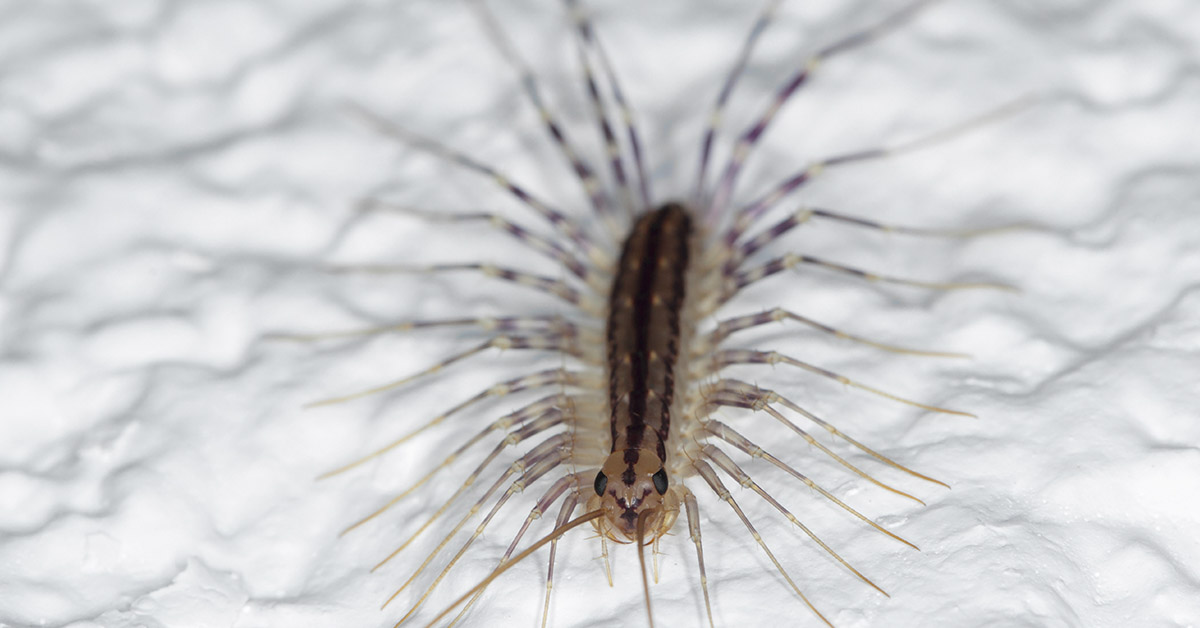Finding a house centipede is its own brand of terror. It doesn’t matter if it’s scuttling across the floor, peering from behind a door, or appearing in a cupboard. These little monsters have 15 pairs of legs and can travel 1.3 feet per second. It’s no wonder why most people are afraid of these creatures, and why the typical reaction to finding one involves a shoe or a rolled-up magazine. But don’t swat at them just yet; house centipedes can actually benefit you and your home.
Don’t Get Rid of House Centipedes
First, it’s important to note that house centipedes are completely harmless (although that won’t make them any more welcome.) But the fact is that centipedes can be helpful exterminators when it comes to killing other pests — less harmless ones. They can kill termites, cockroaches, spiders, silverfish, moths, carpet beetles, and flies. They use their legs to “lasso” up their prey while injecting them with venom from their front two legs. “Centi” means “hundred” but centipedes only have 15 pairs of legs, although it may seem like many more, and they look yellow-gray with stripes across their bodies. They tend to hunt at night. [1]
In the rare chance, a centipede bites a person (which can happen when handled or stomped on with bare feet) the wound could be as painful as a bee sting. It should be treated similarly, by cleaning the bite and applying antiseptic and using ice to reduce any swelling.
Read: If you see a worm with a white band around it, kill it
While they work as exterminators, house centipedes don’t leave any kind of webs or nests behind. So they are neat houseguests compared to other insects. Their purpose is to hunt for the other bugs, and they don’t carry any diseases or eat through your clothes or wooden furniture.
Of course, the ideal is to have zero creepy crawlies around the home, whether they’re helpful or not. Centipedes often venture indoors to find shelter from the harsh and cold weather. They also are attracted to humidity, which they could find in damp basements or under leaky sinks. Some of the best ways to get rid of house centipedes are by fixing damp areas and eliminating their food source. As in, get rid of the pests they feed on. [2]
Read: What Really Happens When A House Fly Lands On Your Food
How to Get Rid of Centipedes
First, make sure there isn’t any extra moisture in the walls, which you could fix by getting a dehumidifier or getting a fan installed in the bathrooms. Next, clear your home of any debris that’s causing moisture to leak into the walls. Check under sinks and in the basement for leaks. Ensure shower and sink drains are working properly and leaving no puddles to attract house centipedes. [3]
Next, seal any cracks and openings that might appear around doors, windowsills, and corners. You may also find them where pipes and electric lines enter the home. Leave no hole for any creepy crawlies to get through. This step may also help with eliminating other pests, which are the centipedes’ food. If there is no prey around, they will have to hunt elsewhere. But if the prey sticks around, it’s likely more centipedes will follow.
With this in mind, mend any torn screens and maintain the weatherstripping around the doors and windows. Sweep away any spiderwebs when you find them. Check your crawlspaces and basement for any nests or scrambling cockroaches. Check the dryer vent to ensure it is sealed properly to avoid house pests getting inside. Set up sticky traps, cedarwood sprays, vinegar baths, and sprinkle baking soda around problematic areas. Of course, call pest control to solve the problem when necessary.
When you are on the prowl for a particular centipede, don’t crush it with a tissue. This could leave some unpleasant and sticky stains. Instead, use a vacuum to grab any escapees and empty the vacuum cup or bag into a sealable plastic bag and deposit it in an outdoor garbage can. You can also invest in diatomaceous earth, which is a powdered substance that could kill different kinds of indoor pests. Sprinkle the substance around corners, doors, cracks, and damp areas; wait at least 24 hours before vacuuming it all up. While you’re at it, centipedes are often found around bathrooms and sinks, so pour vinegar or bleach (not both since the combination could be dangerous) down the drain to get rid of potential lurkers. [4]
In the event of a serious infestation, invest in insecticide sprays or dust (taking care to follow the safety instructions), or even a professional exterminator. Yes, house centipedes may not be dangerous, and yes, they may help hunt other pests. But most people would prefer not to host these many-legged monsters for so long.
Keep Reading: A Single Opossum Can Kill 5,000 Ticks In One Season, Which Spread Lyme Disease
Sources
- “Michigan house centipedes: Why you shouldn’t kill them.” Click on Detroit. Ken Haddad. September 12, 2021
- “Here’s why you should never kill a centipede you find in your house.” Insider. The Family Handyman Staff. May 10, 2018
- “25 Tips for Controlling Pests In and Around Your Home.” Family Handyman. Jenny Stanley. August 25, 2021
- “How to Control (and Prevent) House Centipedes.” The Spruce. Peg Aloi.September 7, 2022

